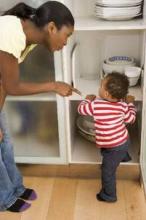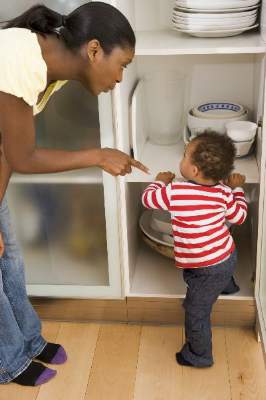User login
As part of its “Essentials for Parenting Toddlers and Preschoolers” series, the Centers for Disease Control and Prevention has released some recommendations for parents on how to use discipline and consequences to address unwanted behavior in young children.
What happens immediately after a child’s behaviors – whether good or bad – can make the action more or less likely to occur in the future, according to the CDC. This is why appropriate consequences are so important.
While praise and other types of positive consequences may be used to reward desired behavior, parents should also know when to use different types of discipline, or negative consequences, when a child has misbehaved in some way.
The CDC suggests that following negative consequences be used to discipline bad behavior and make those behaviors less likely to happen again:
1. Ignoring. Taking attention away from a child who is whining or throwing a tantrum can decrease the likelihood of the behavior continuing. When using ignoring as a form of discipline, avoid all eye contact, conversation, and attempts to get your attention.
2. Distraction. Using distractions such as games and toys can stop unwanted behaviors by redirecting the child’s focus elsewhere.
3. Natural consequences. In some situations, the negative consequences that naturally occur as the result of a bad behavior may serve as punishment in itself. For instance, if a child repeatedly bangs a toy and it breaks, the child has learned from his or her mistakes by seeing the consequence firsthand. The only caveat to allowing natural consequences to happen is to be careful that this does not put the child in danger.
4. Delay of a privilege. This method may involve taking away toys that are not handled carefully or not allowing the child to play outside until they have cleaned up their toys. This teaches the child about logical consequences that are directly related to their actions.
5. Time-Out. This involves removing the child from anything that may be distracting or hold his or her attention.
To learn more about effective discipline, visit the CDC website. To view examples of how to use discipline with toddlers, watch the video “How to Use Discipline and Consequences.”
As part of its “Essentials for Parenting Toddlers and Preschoolers” series, the Centers for Disease Control and Prevention has released some recommendations for parents on how to use discipline and consequences to address unwanted behavior in young children.
What happens immediately after a child’s behaviors – whether good or bad – can make the action more or less likely to occur in the future, according to the CDC. This is why appropriate consequences are so important.
While praise and other types of positive consequences may be used to reward desired behavior, parents should also know when to use different types of discipline, or negative consequences, when a child has misbehaved in some way.
The CDC suggests that following negative consequences be used to discipline bad behavior and make those behaviors less likely to happen again:
1. Ignoring. Taking attention away from a child who is whining or throwing a tantrum can decrease the likelihood of the behavior continuing. When using ignoring as a form of discipline, avoid all eye contact, conversation, and attempts to get your attention.
2. Distraction. Using distractions such as games and toys can stop unwanted behaviors by redirecting the child’s focus elsewhere.
3. Natural consequences. In some situations, the negative consequences that naturally occur as the result of a bad behavior may serve as punishment in itself. For instance, if a child repeatedly bangs a toy and it breaks, the child has learned from his or her mistakes by seeing the consequence firsthand. The only caveat to allowing natural consequences to happen is to be careful that this does not put the child in danger.
4. Delay of a privilege. This method may involve taking away toys that are not handled carefully or not allowing the child to play outside until they have cleaned up their toys. This teaches the child about logical consequences that are directly related to their actions.
5. Time-Out. This involves removing the child from anything that may be distracting or hold his or her attention.
To learn more about effective discipline, visit the CDC website. To view examples of how to use discipline with toddlers, watch the video “How to Use Discipline and Consequences.”
As part of its “Essentials for Parenting Toddlers and Preschoolers” series, the Centers for Disease Control and Prevention has released some recommendations for parents on how to use discipline and consequences to address unwanted behavior in young children.
What happens immediately after a child’s behaviors – whether good or bad – can make the action more or less likely to occur in the future, according to the CDC. This is why appropriate consequences are so important.
While praise and other types of positive consequences may be used to reward desired behavior, parents should also know when to use different types of discipline, or negative consequences, when a child has misbehaved in some way.
The CDC suggests that following negative consequences be used to discipline bad behavior and make those behaviors less likely to happen again:
1. Ignoring. Taking attention away from a child who is whining or throwing a tantrum can decrease the likelihood of the behavior continuing. When using ignoring as a form of discipline, avoid all eye contact, conversation, and attempts to get your attention.
2. Distraction. Using distractions such as games and toys can stop unwanted behaviors by redirecting the child’s focus elsewhere.
3. Natural consequences. In some situations, the negative consequences that naturally occur as the result of a bad behavior may serve as punishment in itself. For instance, if a child repeatedly bangs a toy and it breaks, the child has learned from his or her mistakes by seeing the consequence firsthand. The only caveat to allowing natural consequences to happen is to be careful that this does not put the child in danger.
4. Delay of a privilege. This method may involve taking away toys that are not handled carefully or not allowing the child to play outside until they have cleaned up their toys. This teaches the child about logical consequences that are directly related to their actions.
5. Time-Out. This involves removing the child from anything that may be distracting or hold his or her attention.
To learn more about effective discipline, visit the CDC website. To view examples of how to use discipline with toddlers, watch the video “How to Use Discipline and Consequences.”

